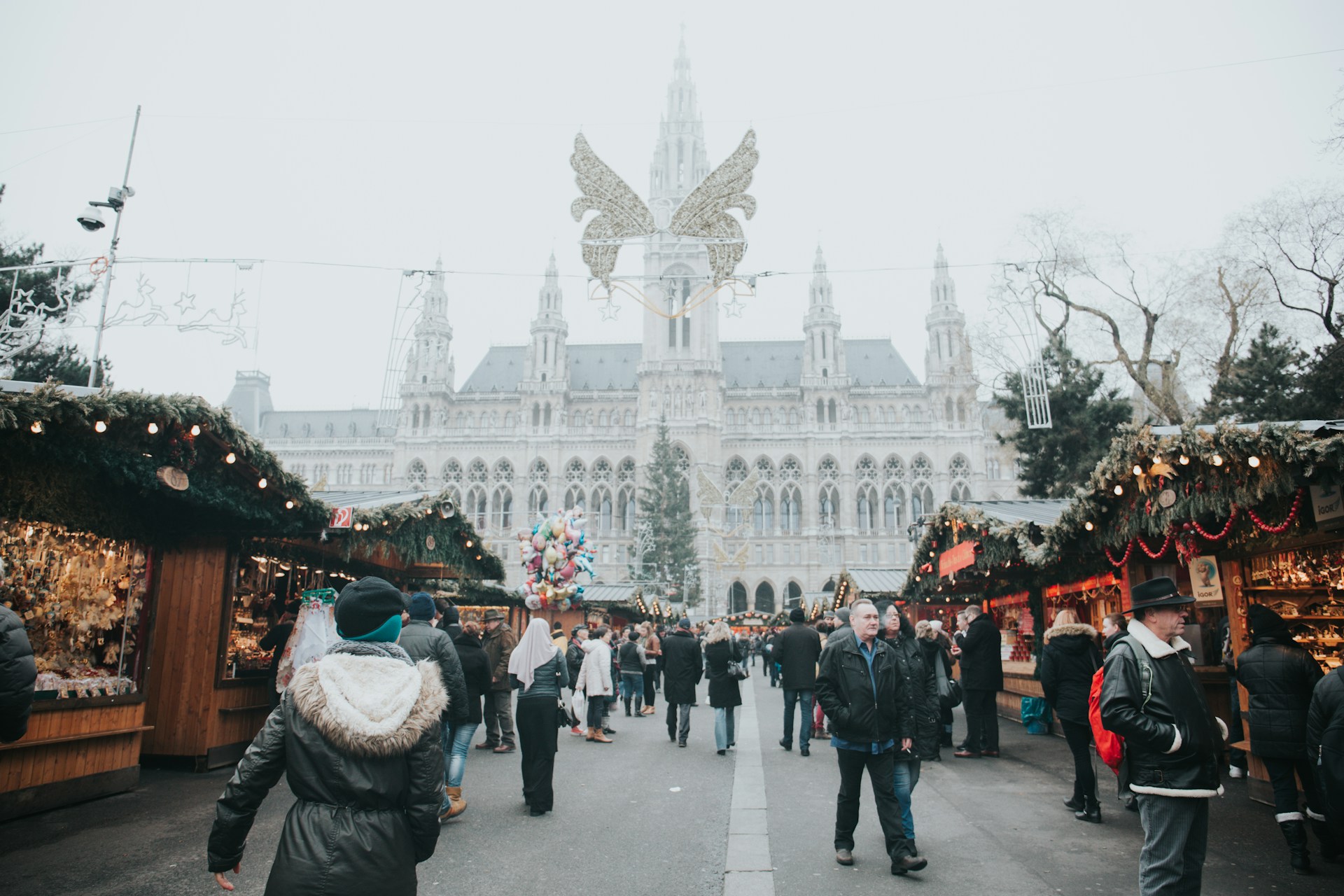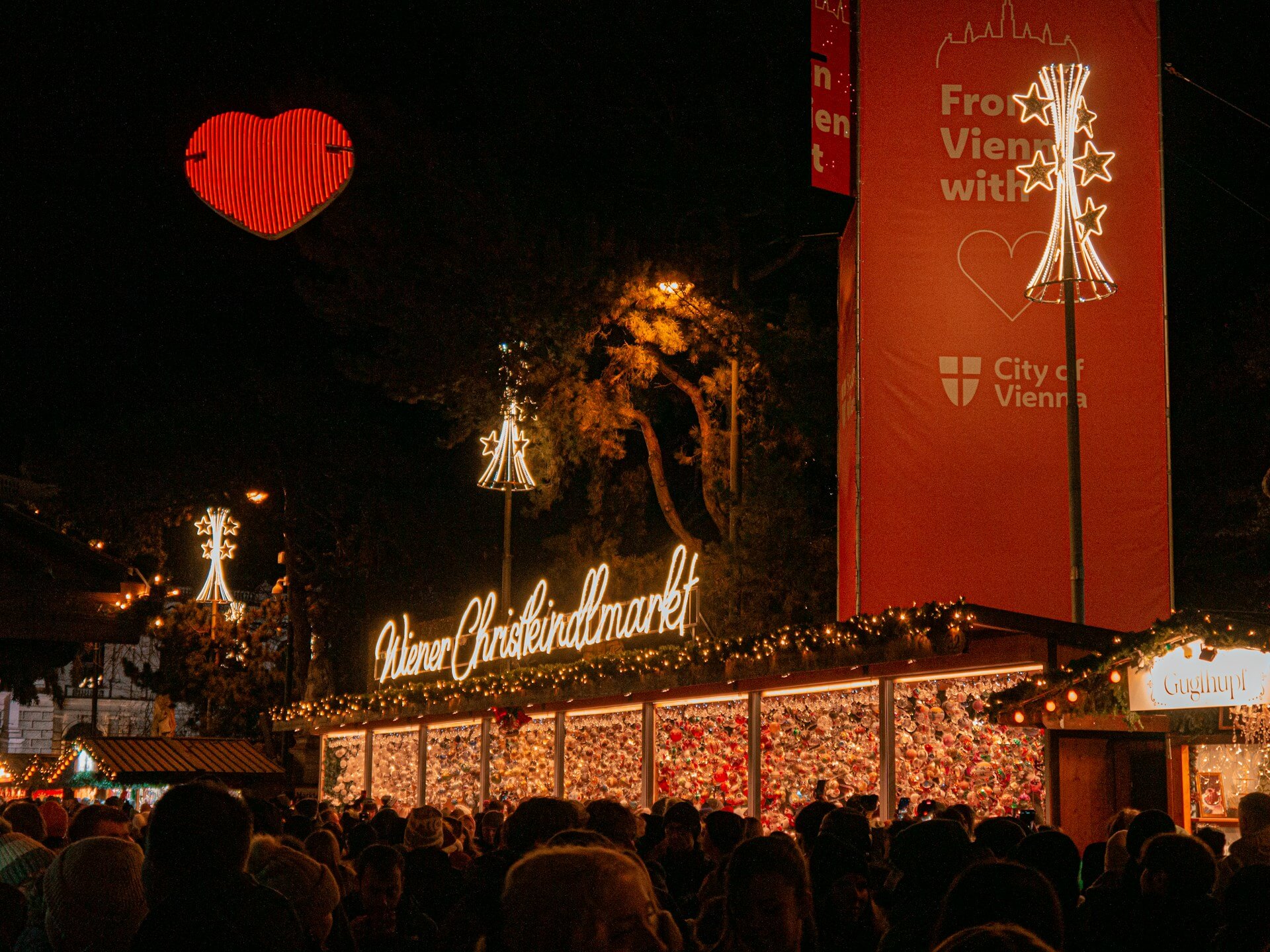By mid-November, Vienna begins to prepare for Christmas and New Year and… change. The air fills with the scent of cinnamon and roasted chestnuts, and the first fairy lights appear on the streets. By early December, the entire city centre glows, and winter celebrations continue until February!
December is the busiest month in Vienna, so it’s best to look for a hotel 1–2 months before your trip. Rooms in the centre, near the Town Hall and squares where the fairs are held, sell out especially fast.
» READ MORE – Vienna – a city of entertainment: things to do on holiday
An audio guide walk is a convenient way to get to know Vienna at your own pace. You can turn it on at any time, follow the route, or simply listen to the stories around you. All you need are headphones and a little curiosity.
St. Nicholas Day and Krampus
On 6 December, real magic begins throughout Austria: children put their polished boots by the door and wait for gifts from St. Nicholas. In the morning, they find apples, nuts and chocolate inside. But not everyone is calm on this day – the saint is accompanied by a retinue of devils and angels. The latter behave kindly, giving out sweets and souvenirs. The former fight among themselves and even tease the police. The horned hooligans get away with everything! The Krampus parade is one of the most colourful and memorable winter traditions in Vienna.
Who brings gifts
In Austria, gifts for children are brought not by Santa Claus, but by Christkind – the «Child of Christ», an angelic figure in white, symbolising purity and light. According to tradition, Christkind appears on Christmas Eve when the lights on the tree are lit and bells ring. The children leave the room and later see gifts under the tree, as if left by an invisible angel. St. Nicholas, who comes on 6 December, only heralds the holiday, while Santa Claus is more of a guest from the movies. For the Viennese, it is Christkind who embodies the spirit of Christmas – quiet, homely and wonderful.
Vienna’s main Christmas tree
Austrians cherish traditions, and the essential attributes of the holiday are figures of biblical heroes, angels, Christmas trees and bells. The location of the main Christmas tree in the capital has remained unchanged for more than 60 years: the square near the City Hall.
Every year, representatives of one of the eight federal states bring a beautiful green tree. Why not nine? Because Vienna is the ninth!
People gather at the foot of the tree, take photos, and stand with mugs of punch, admiring the lights. For the residents of Vienna, this moment marks the true beginning of the holidays.
How Vienna lives during Christmas
For lovers of festive crowds, Vienna is a real paradise! All the capital’s parks and museum complexes are open every day.
Where you will definitely enjoy yourself:
- On the New Year’s Trail. It starts near the main Christmas tree and runs through Prater Park. The trail opens in early November and features attractions, concert venues with laser shows, restaurants, cafés and shops along its entire length. They serve the most delicious coffee here!
- On Graben Street. You can dance until you drop at Rathausplatz, but only here can you attend free open-air masterclasses and learn ballroom dancing from real professionals
- At Heldenplatz. The square hosts pyrotechnic competitions, and each firework display outshines the last
- In Schloss Park. The complex is located next to the former summer residence of Empress Sissi. Peace reigns here. The only downside is that the complex closes every evening
- At St. Stephen’s Cathedral. The cathedral’s excursion programmes are recognised as the best. Want to admire the city from above? Why limit yourself to the Ferris wheel?! Climb more than 300 steps and ascend the cathedral tower!
This is just a small sample of Vienna’s entertainment options, which would be unthinkable without boat trips on the Danube!
Cruise on the DanubeIn Austria, the most important New Year’s Eve performance is Strauss’s operetta Die Fledermaus. It is staged at the Vienna State Opera, where Mozart’s immortal music fills the festive season.
Please note!
- Tickets for gala concerts at the City Hall are quite expensive, but during the Christmas holidays, to the delight of music lovers, Vienna’s churches host free charity concerts of organ music featuring world-famous stars
- Every day, the old imperial palace train on wheels departs from the capital, where you can enjoy dinner and dancing in a romantic candlelit setting
- A tourist tram runs through central Vienna. The cost of the trip is symbolic, and there’s no need to pay for a guide – an audio guide is included
Vienna Christmas markets
In December, Vienna transforms into a huge festive market, where every corner breathes with the aroma of cinnamon, roasted almonds and punch. Here are the most famous Christmas markets worth visiting:
- The market at the Town Hall (Christkindlmarkt) is the largest and most famous. There is an ice rink, dozens of wooden stalls with souvenirs, mulled wine and sweets. In the evening, the Town Hall building is illuminated, and an orchestra performs nearby
- The Belvedere Fair is a romantic place with old-fashioned swings, carousels, live deer and real tower trumpeters. The most delicious strudels and farm cheeses can be found here. The village welcomes guests from 11 November until New Year’s Eve
- Schönbrunn – this event has an international format and offers insights into the cultures of different European countries. Chalets with folk crafts open on the eve of Catholic Christmas
- Art Advent on Karlsplatz is a creative alternative to classic bazaars: art installations, music stages, natural food and eco-friendly souvenirs
- The market at Maria Theresa Square and in the Old Town offers a wide selection of folk crafts and an engaging musical programme
Most fairs close on 26 December, but that’s only the beginning of the sales season, which lasts until March.
» READ MORE – Paris Christmas markets on the map!
What to try during the holidays
During the festive season, restaurants serve the best of Austrian cuisine, and the list of delicacies is as vast as the Danube.
It includes fish dishes made from carp and trout, sausages, baked pork, veal, goose, Christmas logs, strudels, soups with croutons, noodles, cabbage, beans, greens and much more.
If you are on a diet, give up in advance!
Where to eat during the holidays – on 24–25 December, look for tables in hotel restaurants or places near popular attractions: in the Ring area, on Kärntner Straße and near St. Stephen’s Cathedral. Be sure to book in advance – even street cafés are often full.
» READ MORE – Berlin celebrates: where to spend Christmas and New Year’s Eve in style?
Where and how to celebrate New Year’s Eve in Vienna
Fun and regal – the city centre turns into one big stage: the famous Silvesterpfad New Year’s Eve trail runs through Graben, Kärntner Strasse and St. Stephen’s Square.
- Silvesterpfad features dozens of stages playing jazz, rock and classical music. On one square, people dance the waltz, while on another, lessons are held for beginners. Everything is free, and even if you’ve never danced before, it’s impossible to resist
- Concerts and shows – orchestras perform on Rathausplatz, DJs and laser shows take over Heldenplatz. There is noise, light and laughter everywhere, and street performers roam between the squares
- Fireworks and the midnight waltz – at midnight sharp, the sky above Vienna lights up with fireworks. At that moment, Strauss’s Blue Danube plays on the radio and in the streets, and hundreds of couples begin to dance right under the open sky
New Year’s Eve here feels like a celebration for everyone – informal, warm and musical, where strangers hug and wish each other «Prosit Neujahr!» – Happy New Year.
» READ MORE – 10 ideas for celebrating Christmas and New Year in New York
Music and waltzes
Vienna doesn’t just decorate the holidays with music at Christmas – it lives and breathes it.
Vivaldi's «Four Seasons» concert at Karlskirche- The Vienna Philharmonic Orchestra’s New Year’s Concert is broadcast worldwide on 1 January. The Golden Musikverein Hall fills with the sounds of Strauss and Mozart, and those who don’t get tickets watch the broadcast on screens throughout the city
- Waltzing to the chimes – at midnight on 31 December, the Blue Danube waltz plays. Couples dance in squares, hotels and even on the streets – a tradition that unites the whole city
- Ball season – January and February transform Vienna into the capital of dance. Hundreds of events take place in palaces and concert halls, and even beginners can sign up for a short waltz course to feel part of the magic
The best balls and venues
Have you always dreamed of attending a real ball? Vienna is the perfect place to make that dream come true – not just at Christmas!
Top 5 ball venues in the capital:
- Vienna State Opera – traditionally, in the first half of February, it gathers world-famous stars. It’s hard to call this event strictly a New Year’s or Christmas ball, but it certainly feels like one
- The Imperial Palace (winter residence) – its highlights are sweets, coffee and extravagant shows
- Vienna City Hall – hosts an entire series of celebrations, including the famous Flower Ball
- Concert Hall on Karlsplatz – January events here are particularly exquisite, designed for those who value tradition
- Concert House – the main Christmas Candy Ball also takes place here in February. Guests traditionally choose the sweetest lady of the evening
There’s even a gradation of balls, just as in old times, according to professional guilds: for lawyers, doctors, musicians, police officers and civil servants. Today, foreigners can easily attend such events – the key is to purchase a ticket in advance and follow the dress code.
How to spend 1 January in Vienna
The first day of the year in Vienna begins with music. In the morning, the Vienna Philharmonic Orchestra’s concert is broadcast throughout the city – you can watch it on outdoor screens or listen from cafés, where the steam from coffee curls in the frosty air.
After the concert, locals and tourists go for a stroll: the parks and embankments of the Danube come alive, and the squares remain lit up. Stop by a café for a late breakfast, taste a New Year’s strudel and enjoy the first hours of the year.
The Chinese New Year is rarely celebrated in Austria, but at the end of January and the beginning of February, shops offer discounts of up to 80% on premium chocolate.
Vienna knows how to celebrate with taste, music and shimmering lights at Christmas. But the journey doesn’t end there. Ahead lie new cities, new squares and the aroma of cinnamon and punch, which makes all of Europe feel a little warmer.
See you at the Christmas markets in other cities – there are still many wonders ahead!





 Story Taler / Pixabay
Story Taler / Pixabay  Yann Allegre / unsplash.com
Yann Allegre / unsplash.com  Sandro Gonzalez / Unsplash
Sandro Gonzalez / Unsplash  Simon Berger / Unsplash
Simon Berger / Unsplash  Al Elmes / Unsplash
Al Elmes / Unsplash Ketevan Salia / Unsplash
Ketevan Salia / Unsplash
Leave a Reply
Want to join the discussion?Feel free to contribute!